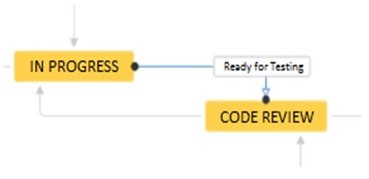
- Email support@dumps4free.com

A team of technical writers works in the WRITE project. The project uses a single, shared
workflow.
To better match the team’s way of working they request a workflow change:
The initial status of their project’s workflow should be changed from Open to
Awaiting Inspiration.
You navigate to the Workflows section of the administration, update the Name of the status
in the workflow
designer and publish your change.
What are two implications of this change? (Choose two.)
A.
A. The workflow scheme for the WRITE project will need to be published before the change takes effect.
B.
Awaiting Inspiration will be created as a new Status in Jira.
C.
Transitions to the Awaiting Inspiration status will fail until the post functions for those transitions are
updated.
D.
Filters and Gadgets that referred to the Open status by name will be broken.
E.
The Open Status will be changed to Awaiting Inspiration in all workflows using that status.
A. The workflow scheme for the WRITE project will need to be published before the change takes effect.
Awaiting Inspiration will be created as a new Status in Jira.
Which time tracking configuration can be controlled on a global basis for all projects in Jira?
A.
which users or groups have the ability to log work on issues
B.
whether time tracking fields are available on standard versus sub-task issue types
C.
the default time unit on estimates when users don’t explicitly specify one
D.
which users have the ability to edit or delete their own or other users’ worklogs
E.
whether Original Estimate is required when creating issues
the default time unit on estimates when users don’t explicitly specify one
Reference: https://www.softwaretestinghelp.com/jira-time-tracking/
A user says she can see the Ready for Testing transition but cannot successfully execute it. Why can’t the user execute this transition?
A.
The status property of Code Review prevents the Developer role from executing the transition.
B.
A Condition on the transition requires the user to be in the Developer role.
C.
A Validator on the workflow transition requires the user to be in the Developer role.
D.
The status property of In Progress prevents the Developer role from executing the transition.
The status property of In Progress prevents the Developer role from executing the transition.
The Release Manager is having problems caused by inconsistent naming of versions across projects. He would like to use a more consistent naming convention. The developers do not know the naming convention, and are happy to let the Release Manager rename versions when they get the names wrong.
The projects all use the Default Permission Scheme. Which action would allow the Release Manager to update the versions in the projects?
A.
Change the Manage Versions permission in the permission scheme.
B.
Change the workflow to allow the Release Manager to update versions.
C.
Add the Release Manager to the Administrators project role.
D.
Add the Release Manager to the developer role.
Change the workflow to allow the Release Manager to update versions.
Your marketing company wants to evaluate Jira and purchased a 10-user license. A
frequently changing
group of key stakeholders – both internal employees and external customers – will
participate in the
evaluation.
If the evaluation is successful the company wants all 50 employees to start working with
the tool.
You have to manage the frequently changing group of stakeholders and need to make sure
only the intended
users participate in the evaluation.
How should you meet these requirements?
A.
Create and manage the users for stakeholders manually in the internal directory.
B.
Connect Jira to your internal LDAP directory and whitelist the IPs of stakeholders.
C.
Enable public signup and CAPTCHA but limit account creation to stakeholders.
D.
Disable public signup and grant all project permissions to Group Anyone.
Disable public signup and grant all project permissions to Group Anyone.
| Page 3 out of 15 Pages |
| Previous |